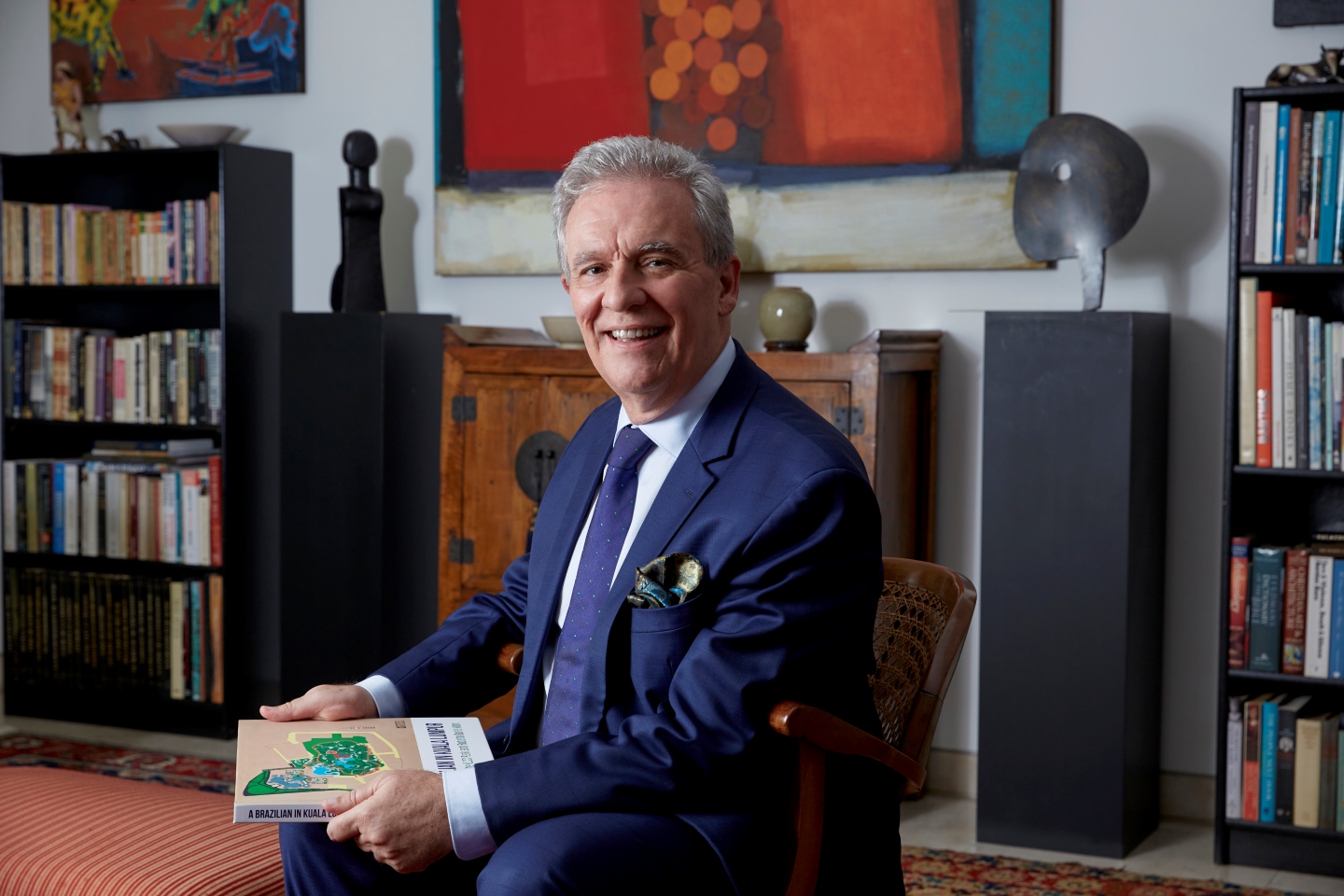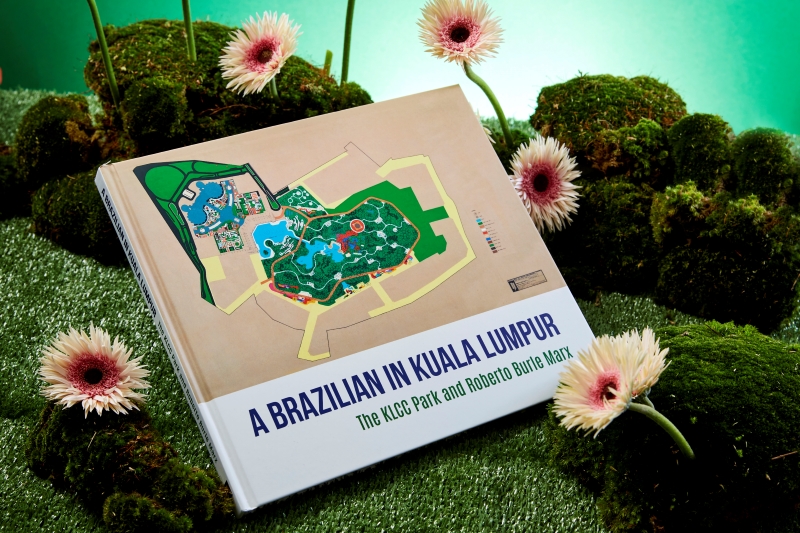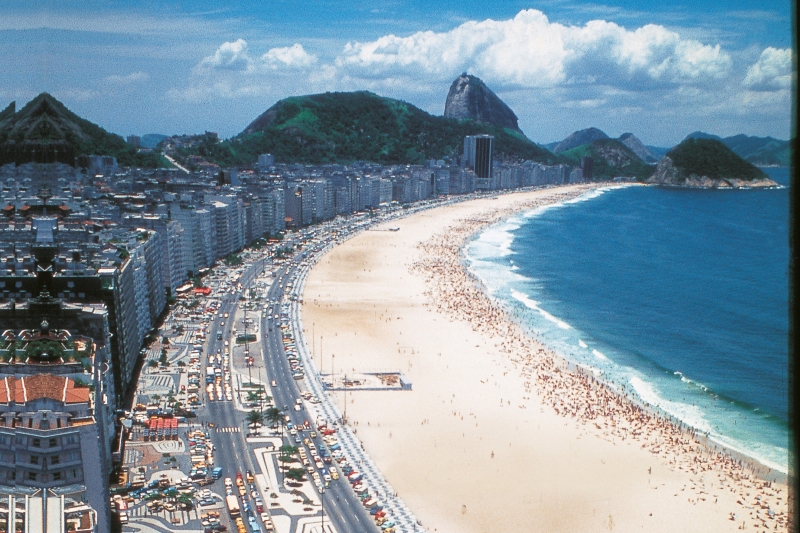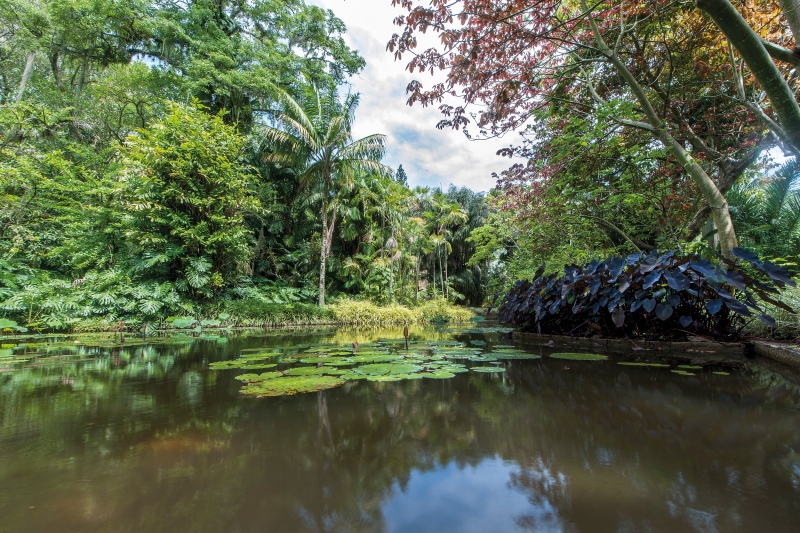
Quintella: I have always considered it a tremendous privilege to work in Kuala Lumpur and Malaysia (Photo: SooPhye)
It is a searing-hot afternoon in downtown Kuala Lumpur, but the official residence of the ambassador of Brazil is cool and serene. Tea is being served, along with a rare treat: bolo de rolo, a type of rolled cake, finely layered with guava paste, hand-delivered from Rio Grande do Norte in Brazil’s northeast. From the lofty 19th-level penthouse, one enjoys a great vantage point of KLCC Park, a green lung right smack in the heart of the Malaysian metropolis. For His Excellency Ary Norton de Murat Quintella, however, the pleasure is particularly immense.
“I have always considered it a tremendous privilege to work in Kuala Lumpur and Malaysia,” says the amiable 61-year-old career diplomat. Posted here since 2020, arriving a scant two months before the world went into lockdown, the newcomer to the city found comfort in the soothing sight of this urban oasis — particularly when he was sequestered alone for most of the pandemic’s scary first year. “Living in a flat overlooking KLCC Park, as I do, is indeed a bonus. I look out onto it every single morning and evening and cross it on foot most days, permanently aware of the fact that at the base of the imposing Petronas Twin Towers is not just a beautiful park but a reminder of how strong and meaningful the connection is between our two countries.”
Of samba + sambal
Separated by a distance of about 17,000km, Malaysia and Brazil are as far apart as two countries can be. There are no direct flights from KL as yet (although the easiest route at present would be via Dubai, as Emirates flies directly to Rio de Janeiro and São Paulo). Yet, both have shared a bond for centuries. Some might remember how Malaysia’s rubber industry (the country was the world’s largest producer of natural rubber in the 1960s and 1970s) was born out of the latex obtained from Hevea brasiliensis, a species of rubber tree originally native to the Amazon basin, brought over in the 1800s and planted with manic fervour by the colonial botanist H N Ridley.
A modern-day example of bi-national bonds may, however, be witnessed right from the ambassador’s terrace. Few are aware that KLCC Park is, in fact, the only project of the great Roberto Burle Marx, often referred to as the “Picasso of landscape architecture”, in Asia and quite possibly one of his final professional undertakings before his passing in 1994.
Born in São Paulo in 1909, the year Ipoh’s famous clock tower was unveiled to commemorate J W W Birch, the slain first British Resident of Perak, Burle Marx moved with his family to Rio in 1913. But it was only as a young student studying painting in Germany, where he would often visit the Botanical Garden in Berlin, that he first learnt about the rich flora of his homeland. “He was a polymath, talented also in the visual arts,” Quintella quips. Returning to Brazil in 1930, the young Burle Marx began amassing native plants with gusto and soon had a great collection of them at home. Three years later, he would complete his first garden design.
202323639a.jpg

Fashioning Eden
When grand landscaping is talked about, the most celebrated names that come to mind are, of course, the great Le Nôtre, employed by Louis XIV to design Versailles’ renowned gardens; Capability Brown of Chatsworth fame, the grand country pile owned by the Duke of Devonshire, and whose naturalistic parkland style went on to inspire Paris’ Parc Monceau and Munich’s Englischer Garten; and Frederick Law Olmsted, who counterbalanced New York City’s rapid urbanisation with the establishment of Central Park as well as Brooklyn’s Prospect Park. When it comes to modern landscaping, however, there is only Burle Marx.
His peers described how he approached landscape architecture like fine or abstract art, using nature to produce pattern and colour. Perhaps this could be attributed to his trained artist’s eye or innate genius at paring things down to a bare minimum, yet showcasing them to maximum effect. Therefore, it is an opportunity loss that many Malaysians remain unaware of the treasure — that is a touch of Burle Marx’s legacy — right under their nose at KLCC Park. Quintella, ever the diplomat, says reassuringly: “It seems natural to me that people might not know who designed it. After all, we often do not ask ourselves who created a garden, a building, however beautiful and important they may be. My hope is that A Brazilian in Kuala Lumpur may contribute to awaken further interest in Roberto Burle Marx’s work on the part of local landscapers, architects and urbanists, as well as by the Malaysian public in general.”
In A Brazilian in Kuala Lumpur, it is mentioned how KLCC Holdings had hoped for a park that was tropical in essence and yet different from the traditional Malaysian garden. “We must bear in mind that in the early 1990s, Burle Marx was considered, and had been for quite some time, the most prominent in his field globally. So, when the Malaysian authorities decided to install a handsome, elegant urban park in the KLCC neighbourhood, his name came up as a natural choice,” Quintella confirms.
The celebrated landscape architect, already in his 80s then and in frail physical health, travelled to Malaysia — not once, but twice — to establish a hands-on approach to the project as well as learn all he could about Malaysian plant life. The book includes charming vignettes on the shaping of the park and tells of how the flamboyant legend indefatigably explored the country, from the riverfront of Kuching all the way to the Kinabalu National Park in Sabah, just to immerse himself in its diverse flora and architecture. It even states how the Brazilian “relished the pungent offensive aroma” of the durian but loved mangosteen most of all.
Although numerous parks, gardens and mosaic promenades designed by Burle Marx dot the globe — in Miami, Paris, Caracas, Pennsylvania and several key Brazilian cities — the KLCC Park remains the only place in the whole of Asia with his touch. “The park is easily recognisable as a Burle Marx work by its aquatic features, the extensive use of palm tree clusters, and the tiles arranged in geometric patterns on the grounds. He also opted to use mostly species that are native to Malaysia,” Quintella points out. Renowned Singapore-based architect Rene Tan weighs in on the cachet Malaysia enjoys because of this. “Being Brazilian, Burle Marx was the perfect counterpoint to César Pelli, the Argentine architect who designed the Petronas Twin Towers,” he notes. “I like KLCC Park because it has gravitas, serving a powerful ‘horizontal statement’ that graphically complements the metallic vertical punctuations of the Twin Towers. But, even more so, the park serves as the unifying factor for all of the other skyscrapers in the vicinity.”
105_-_avenida_atlantica.jpg

My name is Rio
As a Carioca (a demonym used to reference anything connected to Rio de Janeiro), Quintella muses, “You could say I grew up living alongside the works of Burle Marx solely because I was born there! Many of his iconic projects are now synonymous with the city’s urban landscape, including the famous promenade along Copacabana Beach, where I lived as a small child.”
Certainly, much has been made of the celebrated 4km calçadão, which boasts an attention-arresting black-and-white geometric wave pattern. Designed in 1970, it dominates the entirety of the beachfront sidewalk and is, according to the State Institute of Cultural Heritage, “the largest example of applied art existing in the world”.
Brasília, the modernist capital of Brazil inaugurated in 1960, also owes much to Burle Marx’s aesthetic vision, as several of the public gardens in the new capital were designed by him in the 1960s and 1970s. “I became truly aware of his importance as a landscape artist when I went to live in Brasília for the first time as a teenager,” Quintella says. “Much later, my mother owned a house in Rio for many years and had asked Robério Dias — a former collaborator of Burle Marx’s, who had passed away by then — to build a garden for her. I remember how, every time I set foot in that garden, which overlooks the São Conrado beach down below, I felt a thrill. It was nice knowing our very own garden was inspired by that great man. Sadly, that house was sold in 2019, as she moved into a flat in Ipanema soon after.
“The equally famous embankment along Flamengo Beach and the gardens of Botafogo beach were also Burle Marx designs. Later on, when I joined the diplomatic service at Itamaraty, the building designed by [legendary architect] Oscar Niemeyer that houses the Brazilian Ministry of Foreign Affairs in the capital of Braśilia, I had the daily privilege of working next to the three projects Burle Marx carried out in the building: the water garden on the ground floor; the outdoor water garden; and the suspended garden on the rooftop terrace. I remember how Burle Marx opined in a 1962 lecture that ‘the garden should be, in short, a work of art … like a painting, a sculpture, a symphony, a tapestry’. He was just so talented in so many fields.”
Besides the celebrated tropical gardens, Itamaraty also boasts an impressive tapestry of Burle Marx’s design, representing the flora of the Cerrado region, a vast tropical savannah in eastern Brazil and the second-largest of Brazil’s main habitat types, after the Amazonian rainforest.
Estate of grace
The crème de la crème of the design world, naturally, remains most enthralled by Sítio Santo Antônio da Bica, a sprawling 150-acre estate in Guaratiba, on the fringes of west Rio. It was reported that great names such as Le Corbusier, Frank Lloyd Wright and Walter Gropius regularly gathered there, as Burle Marx was known to be an effusive host, occasionally bursting out in an operatic aria or two. Food and music aside, what Sítio is best known for is being a living museum, nursery and treasure house of the botanically acquisitive landscape architect, with more than 3,500 species of Brazilian plants at one point or another.
“Guaratiba is indeed on Rio’s outskirts, situated near beaches that are relatively less crowded than the more central ones of Copacabana and Ipanema,” Quintella explains. “I have only ever visited Sítio once. It was many, many years ago and I found the entire experience beautiful and quite moving. The estate is now officially called Sítio Roberto Burle Marx. Besides the gardens, which are spectacular, visitors will also find the house contains a good collection of his works as a fine arts painter. There is also a 17th-century chapel on the grounds, dedicated to Saint Anthony, a Portuguese saint who is very popular in Brazil. Bica means ‘tube’ or ‘faucet’, something from which water comes out. So, I am guessing there was once a fountain on the grounds.”
site_1620_0006.jpg

Balancing act
Returning to the subject of A Brazilian in Kuala Lumpur, Quintella admits that, ever since he arrived in Malaysia, he has grappled with the idea of how he could pay homage to “the brilliant Brazilian landscape artist who designed KLCC Park”. Several ideas were, of course, explored but “gradually, it evolved to become a book focused on his most important work here”.
“The book must also, and fundamentally, be regarded as a tribute to Malaysia itself, and a celebration of a wonderful Malaysian park, right here, in the middle of Kuala Lumpur, which can be enjoyed every day by so many residents of the capital city. After I settled on publishing a book on Burle Marx and the KLCC Park, rather than, say, putting on an exhibition, which would be ephemeral by definition, the work took up a year and a half. It was a complex and time-consuming process, which involved several factors.”
Fortunately, financial assistance came by way of the Guimarães Rosa Institute, the agency of the Ministry of Foreign Affairs of Brazil responsible for cultural and educational diplomacy. “I must also add how the Malaysian branch of Vale, a Brazilian multinational whose maritime terminal in Lumut, Perak, is the biggest Latin American investment in Malaysia, covered the costs of the handsome hard cover.”
Much of the materials used in the bilingual book — all texts are in Portuguese and English, with translation work undertaken by the embassy — was courtesy of the Instituto Burle Marx, which holds more than 500 photographs, documents and drawings related to Burle Marx’s project for KLCC Park in Rio de Janeiro. “This material, however, had not been previously catalogued. So, they hired specialists to carry out the work specifically for the embassy to use in A Brazilian in Kuala Lumpur. The material presented in the book is thus being seen for the first time by the public,” Quintella beams. “From the outset, I regarded the publication of the book an important goal and an integral part of my work as ambassador to Malaysia. The moment I settled on the idea, I considered it my responsibility to see it through. I was lucky enough to be able to rely on the support of a very competent Brazilian diplomat in my team, Marcelo Hasunuma, who was in charge of the Cultural Sector at the Embassy of Brazil.
“Because of Malaysia and because duty has brought me to this beautiful and generous country, Roberto Burle Marx’s work has come to somehow synthesise different periods of my life — from the very early years where I lived with my parents and siblings in an apartment on the Copacabana Beach promenade, perched above its lovely curve that hugs the Atlantic Ocean; to several decades later, in different phases of my career, working surrounded by Burle Marx’s gardens at the Brazilian Foreign Ministry in the Itamaraty building in Brasília; to the present, where I overlook the beauty of KLCC Park daily, one of his last projects, from my home here in the heart of Malaysia. Rio, Brasília and now Kuala Lumpur are such important places in my life — and, in all three of them, the work of Roberto Burle Marx lives on.”
This article first appeared on Feb 5, 2024 in The Edge Malaysia.


